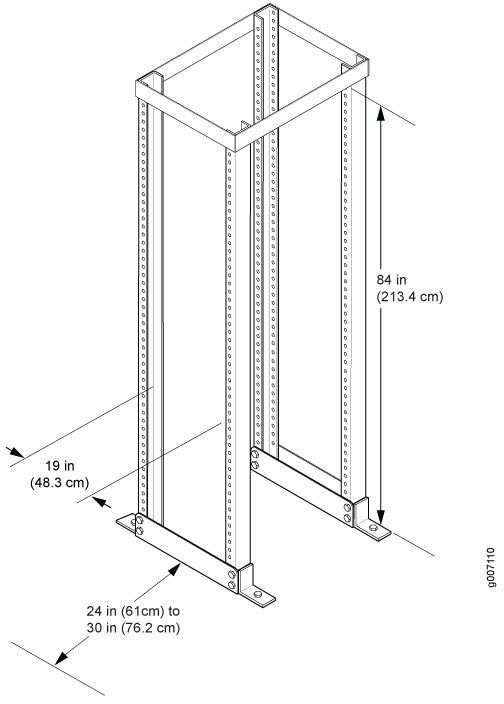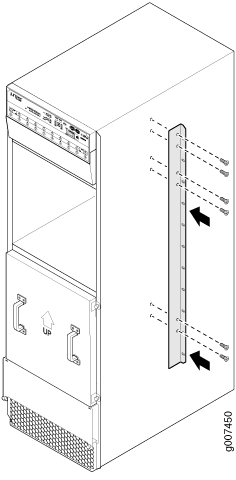MX2010 Rack Requirements
Rack Size and Strength
The MX2010 router is designed for installation in a rack that complies with either of the following standards:
-
A 19-in. rack as defined in Cabinets, Racks, Panels, and Associated Equipment (document number EIA-310-D) published by the Electronics Components Industry Association (http://www.ecianow.org/).
-
A 600-mm rack as defined in the four-part Equipment Engineering (EE); European telecommunications standard for equipment practice (document numbers ETS 300 119-1 through 119-4) published by the European Telecommunications Standards Institute (ETSI). The horizontal spacing between the rails in a rack that complies with this standard is usually wider than the mounting brackets, which measure 19.2 in. (48.8 cm) from the outer edge to outer edge. Use approved wing devices to narrow the opening between the rails as required.
-
A 23-in. rack using appropriate 23-in. to 19-in. rack adapters and an appropriate installation shelf that supports the chassis at the correct vertical position to properly line up the rack mount holes. Juniper Networks does not supply this hardware, but consideration for the size and weight of the chassis is important for a safe installation.
The rack rails must be spaced widely enough to accommodate the chassis’s external dimensions: 59.50 in. (151.1 cm) high, 36.20 in. (91.95 cm) deep, and 19 in. (48.3 cm) wide. The outer edges of the front-mounting flanges extend the width to 19.2 in. (48.8 cm), The spacing of rails and adjacent racks must also allow for the clearances around the chassis and rack that are specified in Clearance Requirements for Airflow and Hardware Maintenance for the MX2010 Router. The cable manager and EMI cover on the front of the chassis is 36.20 in. (91.95 cm) deep. An extended cable manager extends the depth to 40.15 in. (102 cm).
In an open-frame rack, center-mounting is required because the more even distribution of weight provides greater stability. For center-mounting, you use the mounting brackets attached to the center of the chassis for rack mounting (see Figure 2).
For instructions about installing the mounting hardware, see Installing the MX2010 Mounting Hardware for a Four-Post Rack or Cabinet.
The weight and depth of the router depends on the type of cable manager installed.
With the standard or extended cable manager installed, use these guidelines:
-
The rack must have sufficient vertical usable space to accommodate the height of the router: 59.50 in. (151.1 cm). You can install one chassis in a rack. A typical four-post rack measures 84 in. (213.4 cm) high, 24 in. (61 cm) through 30 in. (76.2 cm) deep, and 19 in. (48.3 cm) wide (see Figure 1). A typical open-frame rack measures 84 in. (213.4 cm) high and 19 in. (48.3 cm) wide.
Note:A U is the standard rack unit defined in Cabinets, Racks, Panels, and Associated Equipment (document number EIA-310-D) published by the Electronic Components Industry Association (ECIA) (http://www.ecianow.org).
-
The location of the rack must provide sufficient space to accommodate the depth of the router. The chassis with the standard cable manager is 36.20 in. (91.95 cm) deep.
-
The chassis with the extended cable manager is 40.15 in. (102 cm) deep.
The rack must be strong enough to support the weight of the fully configured router, up to 985 lb (446.79 kg).
For a complete list of chassis configuration and individual line card and component weights and measurements, see MX2010 Physical Specifications.

There must be a minimum of 34-U of usable rack space when installing the MX2010 router.
Spacing of Mounting Bracket and Flange Holes
The holes in the mounting brackets and front-mount-flanges used to attach the chassis to a rack are spaced at 1 U (1.75 in.). The router can be mounted in any rack that provides holes spaced at those distances. Figure 2 shows the chassis center-mounting brackets.

Connection to the Building Structure
Always secure the rack to the structure of the building. If your geographical area is subject to earthquakes, bolt the rack to the floor. For maximum stability, also secure the rack to ceiling brackets.
